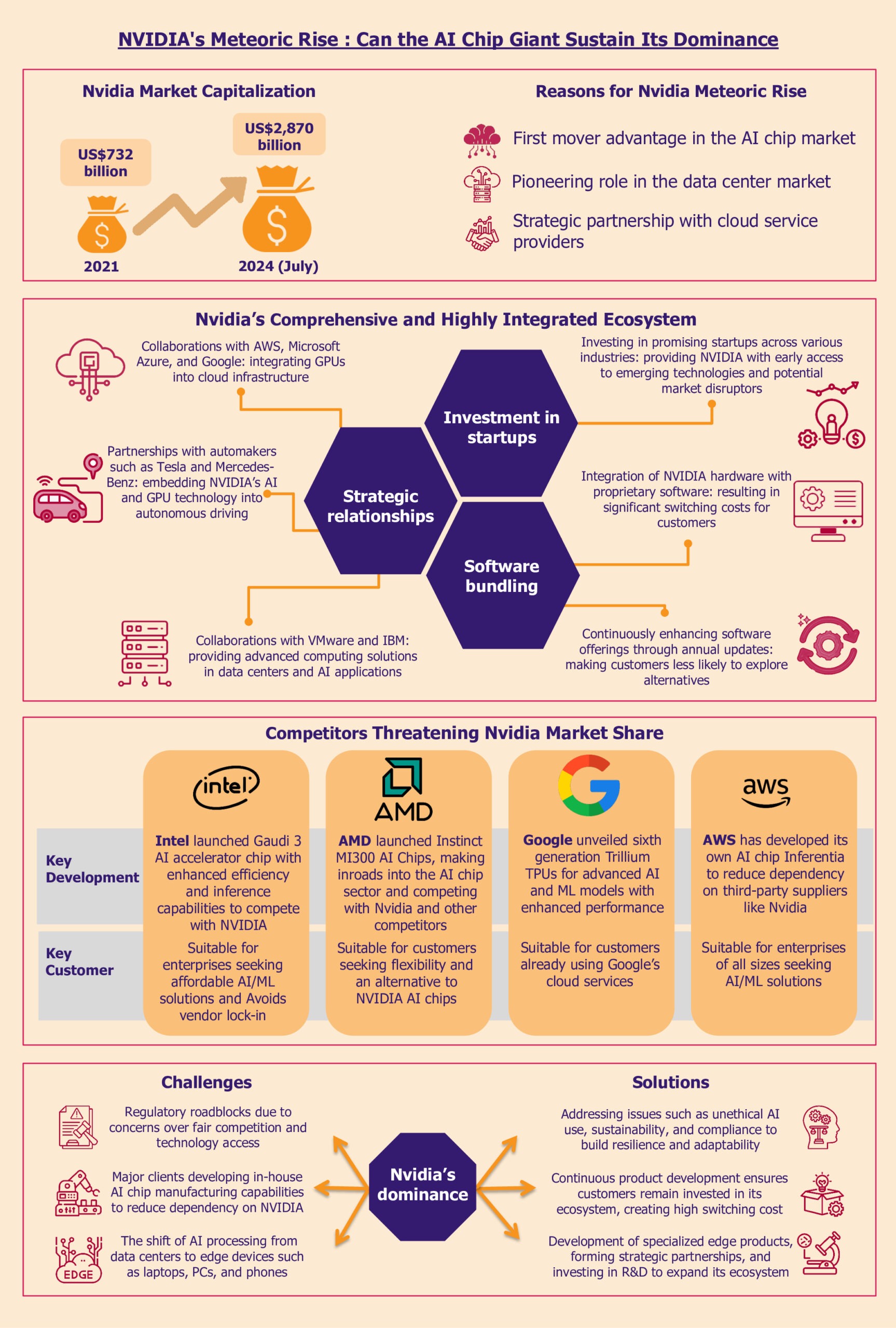NVIDIA has grown exponentially in recent years. The company made significant strides as an early entrant into the AI chip market, becoming the sector’s leading company. In July 2024, NVIDIA’s market cap was US$2.9 trillion, registering 137.1% growth over 2023, making it the world’s third most valuable company behind Microsoft and Apple. As AI development continues its upward trajectory, big tech companies are focusing on developing their AI capabilities more than ever, posing a threat to NVIDIA’s dominance in the AI chip market.
Over the past decade, NVIDIA has evolved from a gaming GPUs maker to a leader in AI and data centers. The company’s early venture into the computing space coupled with continuous development of its cutting-edge technology helped the company solidify its position as the pioneer in the fast-growing AI training and inference market.
According to Mizuho Securities, a Japanese investment and securities firm, NVIDIA holds 70-95% of the advanced AI chip market share in 2024. Despite being the leading firm and major shareholder in the booming AI chip market, NVIDIA started to face rising competition and regulatory scrutiny that challenge its dominance.
Regulatory scrutiny poses a threat to NVIDIA’s market strategy and dominance
NVIDIA’s dominance has caught the attention of regulators worldwide, with antitrust investigations underway in the USA, EU, and China.
The acquisition of ARM, a UK-based semiconductor company, was scrutinized by regulators in multiple countries and was terminated in 2022. This was due to competition and control of key technology. Qualcomm, Google, and Microsoft opposed the deal because of concerns over fair access to ARM’s technology and fair industry practices.
This increased scrutiny may limit NVIDIA’s ability to offer products and services and impact its strategic expansion plans and market dominance.
Competitors are increasingly vying for NVIDIA’s AI chip market share
The global AI chip revenue is projected to reach US$33.4 billion in 2024, per the Gartner market report, making it a lucrative space to operate in. Major tech companies are investing in AI chip development to compete and break NVIDIA’s monopoly in the market.
Through partnerships, innovation, integrated solutions, and niche offerings, competitors are shaping a competitive landscape that will continue to democratize and push AI tech forward. As the AI computing industry will see unprecedented growth, NVIDIA’s competitors are positioning themselves to capitalize on the emerging opportunities.
Tech companies are investing heavily in their AI chip development capabilities
The generative AI boom has exposed how much the big tech companies depend on NVIDIA. NVIDIA’s biggest customers (Microsoft, Google, Amazon, and Meta Platform), which account for over 40% of its revenue, are building their own AI chips to reduce their dependency on NVIDIA.
Amazon, through AWS, offers its own AI chips, Inferentia and Tranium, as cost-effective alternatives to NVIDIA’s chips. Google has been using its tensor processing units (TPUs) since 2015 and recently announced its Trillium chip. Microsoft is building its own AI accelerators, Maia and Cobalt, and Meta is building its own AI chips for more efficiency.
Among all competitors, Intel is likely to emerge as a core competitor to NVIDIA in the AI chip market, leveraging its experience in making CPUs and GPUs. Intel is challenging the company’s dominance in the AI processor market with the Gaudi accelerator AI chip, which costs one-third of NVIDIA’s GPUs.
Intel is focusing on edge devices, such as smartphones, that utilize smaller language models (LLMs) as part of its “AI everywhere” strategy.
NVIDIA is dominating the fast-growing cloud data center market. Intel’s approach of not replicating NVIDIA’s business model but leveraging its broader technology portfolio is likely to provide it with a competitive edge and a chance to compete with NVIDIA.
AI processing shift to edge devices challenges NVIDIA’s market share
Another challenge for the company is the shift in AI processing from data centers to edge devices such as laptops, PCs, and phones.
Large companies, including Apple and Qualcomm, are updating their chips to run AI models on these devices with neural processors for privacy and speed. Apple’s latest devices are AI optimized, and Qualcomm’s new PC chip allows laptops to run Microsoft AI services on-device.
For NVIDIA, adapting to this new paradigm will be important in the long run. As edge AI grows in demand, the company must innovate and compete in this fast-changing market to remain ahead of the competitors.
Investor-backed startups are making strides in the AI chip market
Many new entrants and growing companies are also competing in the AI chip market with innovative approaches and niche solutions.
Startups, such as Graphcore, Cerebras Systems, Groq, and SambaNova Systems, are building specialized AI architectures to outperform traditional GPUs in specific AI tasks. These startups are backed by strong venture capital and strategic partnerships, providing them with resources to enhance their R&D capabilities and scale much faster. For instance, Grog, a startup in the AI inference market, secured US$640 million and claims to have developed an AI chip faster than NVIDIA’s at a much lower price.
The surge in capital investment is likely to support startups in developing new AI chip solutions and carve out a niche for customized AI workloads. This way, startups can tap into new customers seeking customized chips for specific solutions.
Amidst the competition, NVIDIA is expected to leverage its early head start in the AI chip business and will likely focus on its core strength of developing advanced chips.
NVIDIA’s strategic investment in startups strengthens its robust ecosystem
NVIDIA has created an ecosystem that makes it hard for competitors and customers to switch away. Key components of this ecosystem include strategic investments in startups, software bundling, and partnerships, creating a robust and interconnected web.
NVIDIA’s venture capital arm, NVentures, plays a crucial role in product innovation by investing in startups across various industries.
In addition to financial support, NVIDIA also offers these startups access to its technology and expertise to foster innovation and accelerate product development. For example, NVIDIA Inception, a global program, supports startups by providing technology and marketing support, connecting them with venture capitalists, and giving them access to the latest technical and financial resources.
Investing in promising startups provides NVIDIA with early access to emerging technologies and potential market disruptors. This enables the company to integrate the next big technologies into its products or develop new products that keep it ahead of the competition. It fuels innovation and creates a network of companies that are dependent on NVIDIA’s technology, making it hard for them to switch to competitors.
NVIDIA’s seamless hardware-software integration provides a competitive edge
Software bundling is another way NVIDIA strengthens its ecosystem. The company often bundles its hardware with proprietary software, making its products better and more functional. This software is frequently optimized for NVIDIA’s hardware, so customers cannot switch to competitors without losing access to this software. The strategy of bundling often leads to better performance and value for customers, making NVIDIA’s products more attractive.
NVIDIA’s software ecosystem, particularly CUDA (Compute Unified Device Architecture), plays a vital role in its dominance. CUDA only works with NVIDIA’s chips, and over 3 million developers use it to do AI experiments and develop applications. NVIDIA also updates its software annually with new AI chip architectures and software. The company’s continuous innovation ensures its hardware and software are always in sync, so customers stay within the NVIDIA ecosystem.
NVIDIA’s strategic partnerships enable tech integration across sectors
NVIDIA has partnered with companies ranging from tech giants to startups and helps them develop and optimize their software for their hardware. This has created a network of companies across various industries whose products and services are deeply tied to NVIDIA’s technologies.
NVIDIA’s strategy to form partnerships and integrate them into its network of systems and software is beneficial to both parties. Switching to other competitors would incur significant costs and disruptions for customers. NVIDIA’s industry-wide partnerships help it have a strong and integrated ecosystem. For example, partnerships with AWS, Microsoft Azure, and Google Cloud allow NVIDIA to integrate GPUs into the cloud and make their technology available to all enterprises and developers.
In the automotive space, partnerships with Tesla and Mercedes-Benz put NVIDIA’s AI and GPU into autonomous driving, making them rely on NVIDIA AI solutions. Further, partnerships with large enterprises, such as IBM and VMware, to optimize hardware and software make NVIDIA the preferred partner for advanced computing in data centers and AI applications.
NVIDIA’s dominance may lead to increased costs of manufacturing AI chips
NVIDIA’s dominance is likely to significantly impact the world’s largest contract chip maker, TSMC (Taiwan Semiconductor Manufacturing Company), and the entire semiconductor industry.
NVIDIA is TSMC’s key customer, and the latter dedicates a big part of its production capacity to NVIDIA. NVIDIA’s pricing power impacts TSMC’s margins, and if NVIDIA decides to squeeze its suppliers to maintain its margins, TSMC is likely to feel the heat on its profitability. This could lead to capacity constraints for other customers, which will delay their product launches and drive up the prices of AI chips.
An increasing demand for AI chips from NVIDIA and others will drive up the cost of raw materials and components. This cost increase may trickle down the supply chain to end consumers. NVIDIA’s dependence on TSMC makes the supply chain vulnerable to disruptions due to China’s multi-pronged pressure on Taiwan.
NVIDIA’s dominance could drive consolidation in the semiconductor industry
NVIDIA and other companies may diversify their supply chain to mitigate the risks associated with geopolitics, supply, demand, and prices. This could lead to partnering with multiple foundries and geographic diversification. Some semiconductor companies may go for vertical integration to have more control over the value chain.
NVIDIA’s dominance and financial muscle may lead to consolidation in the semiconductor industry. Companies lacking financial resources may find it challenging to compete with big tech companies and could potentially get acquired by larger AI chip manufacturing companies.
Companies in the automotive and electronics sectors that rely on semiconductors may face procurement challenges due to supply shortages. This may lead to prioritizing high-margin products and potentially disrupting the availability of lower-margin products.
EOS Perspective
Only a limited number of global players operate in the AI chip manufacturing space, with NVIDIA holding the majority share. Startups and big tech companies are building strategies to carve out their market share.
NVIDIA will likely hold on to its market leadership with a slight dip in market share to core competitors, such as Intel and AMD, in the next few years. However, with its investments in AI R&R and its initiatives to diversify into different segments, NVIDIA might have a chance to recapture lost market share and grab new growth opportunities in the long term.
As the competition in the AI chip market intensifies, we can expect the launch of more affordable AI chips from NVIDIA competitors designed for customized AI applications. NVIDIA, on the other hand, would prioritize performance and reduce the cost of its AI chips. Since the competitors still lag in designing and developing advanced AI chips and often depend on third parties, NVIDIA is likely to capitalize and dominate the high-performance AI chip space.
With the massive and growing AI market, there is plenty of room for competitors and startups to grow even with a small market share. However, regulatory delays, sustainability issues, and unethical AI use can block strategic initiatives, increase the cost of compliance, and create uncertainty for investors and partners. Navigating these challenges will make NVIDIA more resilient and agile. The increased transparency and compliance can open up new partnership opportunities and new markets in regions where compliance is a major concern.
As AI will be the source of value for many businesses, NVIDIA will use its position to diversify by tapping into new markets to reduce its dependence on traditional markets. A potential partnership the company is discussing with OpenAI, a US-based AI research organization, will likely create a pool of new commercial opportunities for both companies to explore and monetize AI-driven solutions in the healthcare, finance, and automotive sectors.




